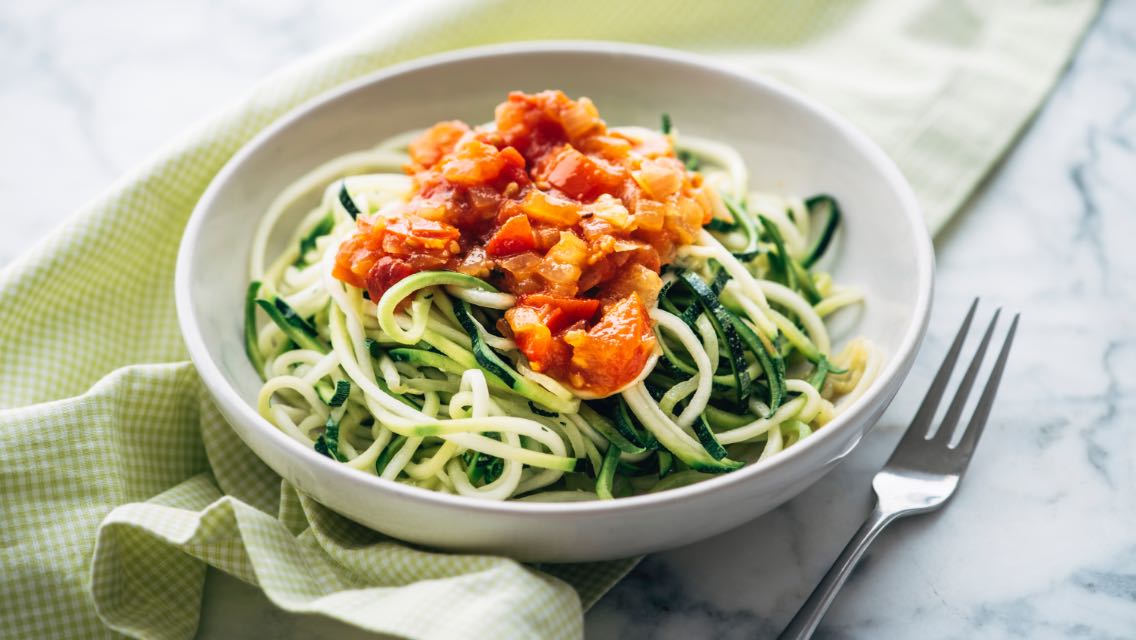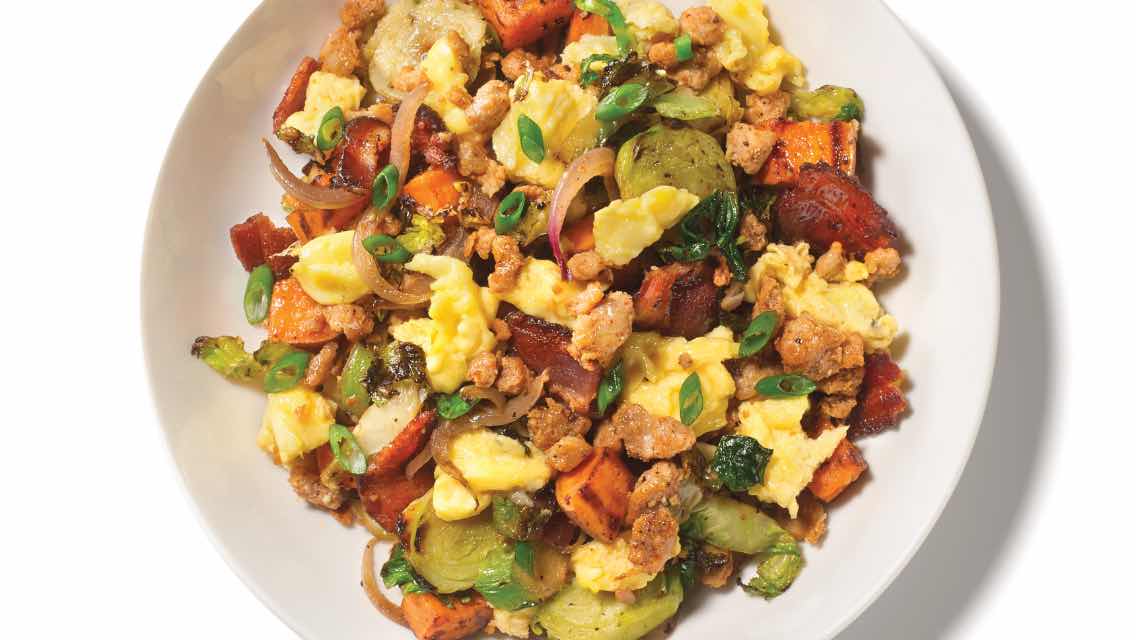We make a lot of decisions around food each day, from what we’re eating to when, where, or with whom. It’s no wonder we can easily feel decision fatigue and often opt for what’s quick and easy, even if it’s less than ideal health-wise.
To up the health quotient of your meals, we’ve compiled this list of good-for-you foods that you can swap in for the not-so-healthy ones. It still requires some decision making, but with all of them laid out for you, the choices are much simpler. And you can take it step-by-step, depending on your starting point.
New to eating healthy? Start here.
These swaps are healthier choices, but aren’t too drastic and will get you moving in the right direction.
- Instead of white, processed carbohydrates, eat whole grains.
This includes bread, pasta, and bagels. The whole grain versions of these items are still processed — and the gluten in them can be problematic for some people — but if you’re going to eat them, whole grains are a better choice because of their fiber content.If you need to, go half-and-half at first. For example, try half white pasta, half whole-grain pasta. Then, once you get used to the taste, make the full swap.
- Instead of sweets and desserts, eat fruit.
Fruit is naturally sweet without containing any added sugar. Plus, it offers beneficial fiber, vitamins, and minerals.
- Instead of sugar, add cinnamon.
In items in which you might typically add sugar (or purchase versions containing added sugar) such as coffee, oatmeal, or yogurt, try a sprinkle of cinnamon instead. This can help reduce your sugar intake, and cinnamon can also help to regulate your blood sugar.
- Instead of drinking fruit juice, eat fruit.
It takes a few servings of fruit to fill a glass of juice, meaning you’ll get a larger serving of sugar than if you eat the fruit whole instead. Consuming the whole fruit also provides fiber, which can help stabilize blood sugar.
- Instead of drinking soda, drink fruit- and herb-infused water.
One 12-ounce can of cola can have around a whopping 39 grams of sugar — that’s 9.75 teaspoons. Adding sliced fruit or fresh herbs to your water gives it a refreshing flavor, making it more palatable and drastically reducing the amount of added sugar in your diet. You can try fun and flavorful combinations such as strawberry basil or pineapple mint.
- Instead of the bun, eat the fries.
While French fries are processed and definitely aren’t a healthy food, they’re the better choice compared to the processed bun. And choosing to eat only one source of starch at your meal helps cut down your overall carbohydrate intake.
- Instead of ketchup, add fresh tomato.
Ketchup is essentially crushed tomato, but it contains additives like high-fructose corn syrup or cane sugar. Skip those and opt for the whole food instead.
- Instead of salt, add herbs, spices, and citrus.
Sodium is necessary for a variety of biological functions, yet thanks to all the processed and refined foods in most of our diets, many of us are consuming too much. There are, however, many great alternatives for adding flavor — and phytonutrients — to your food. Try dried herbs such as basil, thyme, or oregano; spices such as cumin, cayenne, or nutmeg; aromatics such as onion, garlic, or ginger; and citruses such as lime, lemon, or orange.
- Instead of sugar, add fruit.
Cooking oatmeal? Mash a banana into it. Eating yogurt? Add berries. Making bars? Try pureed dates. These simple substitutions will add sweetness as well as a boost of fiber and nutrients.
- Instead of sweet oatmeal, eat savory oatmeal.
Flavor your oatmeal — and make it more filling — by adding creative, non-sweetened toppings, such as sautéed peppers and mushrooms, an egg, and a little cheese.
Ready to take it to the next level? Try these swaps.
If you feel ready to make even healthier choices, try these substitutions.
- Instead of fruit in your smoothies, add vegetables.
Smoothies are often loaded with fruit, therefore sugar, and it can be easy to overdo it. Swap a few servings of fruit for veggies instead: Spinach, cauliflower, zucchini, and beets are all great adds. You likely won’t even be able to taste them, as the fruit you do add often covers up the taste.
- Instead of whole-wheat bread, eat sprouted, whole-grain bread.
Sprouted grains are often easier to digest than their non-sprouted counterparts. Sprouting grains also helps them retain more of their minerals, and many are higher in protein and lower in carbohydrates. If you’re new to sprouted grains, ease in by trying them toasted.
- Instead of mayo, eat plants.
Try smashing an avocado or spreading some hummus on a sandwich instead of mayo. You could also try an olive tapenade. All three offer healthy fats as well as fiber.
- Instead of traditional pancakes, eat protein pancakes.
Aiming for more protein than sugar in the morning can help regulate your blood sugar throughout the rest of the day. All sorts of recipes are available online, but getting more protein in your pancakes is as simple as combining protein powder, eggs, and a mashed banana. Swapping syrup for nut butter or fruit can also minimize the sugar in your toppings.
- Instead of croutons, add nuts and seeds.
Your salad will still have crunch, without the added carbohydrates or gluten. Nuts and seeds —think sliced almonds, walnuts, or sunflower and pumpkin seeds — are a great way to add anti-inflammatory fats and minerals to your diet.
- Instead of store-bought dressing, use olive oil and vinegar or citrus.
Inflammatory, processed vegetable oils and added sugar are often found in store-bought dressings. For healthy fats and tons of flavor, try a combination of olive oil and vinegar or citrus, such as olive oil with balsamic vinegar and basil, or olive oil with lime juice, cayenne, and cumin.
- Instead of traditional pizza crust, try cauliflower crust.
You can purchase pre-made, store-bought versions or make your own. The crust is still compatible with your favorite toppings, but can keep your blood sugar more stable, as well as ease digestive stress for those sensitive to gluten. (Try these healthy pizza ideas.)
- Instead of hitting the vending machine, keep pre-portioned mixed nuts at your desk.
It can be hard to resist the convenience of a candy bar — but it will only lead to a mid-morning or afternoon blood sugar roller coaster. Avoid the temptation by keeping easy-to-grab nuts on hand— they’re a healthier, more satiating option. Just be sure to check the label first; many nut mixes are high in sodium and can contain unhealthy oils or added sugars. Opt for lightly salted mixes or ones where the nuts themselves are the only ingredient.
- Instead of coffee, drink matcha tea.
Matcha is still caffeinated, but has less caffeine than coffee. It also offers antioxidants and can help with detoxification, making it a healthier choice in the morning.
Ready for a challenge? See if you can make these swaps.
One of the best ways to boost your nutritional health is to eat more vegetables. Add more into your diet by making these substitutions.
- Instead of pasta, eat vegetables.
Spiralized zucchini, yellow squash, carrots, and beets can all be substituted for noodles. If you don’t own a spiralizer — or don’t want to spend money on already-spiralized veggies — spaghetti squash is also a good option.
- Instead of bread, buns, or tortillas, eat vegetables.
Whether you’re making a sandwich, burger, or tacos, try wrapping the dish in a leaf of Bibb lettuce, romaine, or cabbage.
- Instead of chips or popcorn, eat vegetables.
Raw veggies offer the same crunch and go great with guacamole, hummus, or other types of dips. Bell peppers, cucumbers, radishes, and carrots are all good options, in particular, for dipping. If you’re craving salt, sprinkle a little on.
- Instead of cream-based dips, eat vegetables.
Hummus, guacamole, salsa, and baba ghanoush are all common, plant-containing dips. But you can also make tasty dips out of a number of other vegetables, including roasted parsnips, peas, beets, and Swiss chard.
- Instead of toast, eat vegetables.
Sweet potatoes are packed with phytonutrients, fiber, and disease-fighting flavonoids — and they can act as a sweet or savory substitute for toast. Cut a sweet potato into 1/4-inch thick slices and pop a couple in the toaster or toaster oven. Top with nut butter, banana, avocado, or a variety of other toppings.
- Instead of rice, eat vegetables.
Riced cauliflower and broccoli are becoming increasingly popular replacements for rice, and can be bought pre-riced for you at the grocery store, making it a super simple swap.
- Instead of French fries, eat vegetables.
Carrots, green beans, zucchini, sweet potatoes — you can make fries out of tons of different vegetables.
- Instead of cream- or cheese-based sauce, use vegetables.
Tomato sauce is great, and roasted red pepper is also a classic, but there are lots of different sauces you can make from pureed vegetables, such as squash, cauliflower, eggplant — or even avocado. It’s a good way to add flavor and sneak in an extra serving or two of veggies.
- Instead of adding starch, add vegetables.
For recipes that call for a starch, such as soups, try using cauliflower instead. Cauliflower adds creaminess and is full of sulfur-containing phytonutrients that help the body clear out damaging free radicals.
- Instead of flavored yogurt, eat fermented vegetables.
The bacteria in your microbiome play an essential role in your overall health. Foods such as yogurt and kefir are supportive, probiotic options, but they often contain added sugars and sweeteners. Try sauerkraut, kimchi, or fermented pickles for probiotic power.
Feeling good? Consider these additional swaps.
Though not actually food swaps, these final tips can help you move toward a healthier way of eating.
- Instead of quantity, focus on quality.
The quality and source of your food is more critical than the number of calories it contains. For example, you could eat a fast-food sausage and egg breakfast sandwich for just under 500 calories, or you could eat three eggs and a half cup of peppers and onions cooked in a healthy oil. While the numbers are similar, the effect on your body is not: The latter option isn’t inflammatory or processed, offers more nutrients, and will keep you satiated longer.
- Instead of purchasing food products, purchase food.
Are you eating something you made or something a company made for you? If you cook from scratch, you’re in control of what goes into your food. If a company is making it, you lose that control, and will likely end up consuming more sugar, salt, and unhealthy fats.
- Instead of ordering your usual, go for variety.
Eating the same thing over and over can get a little boring, and it can also increase your risk for developing a food sensitivity. It means you’re missing out on a variety of nutrients that a diverse diet can deliver. Try stepping out of your comfort zone once in a while, whatever that means for you — maybe it’s trying a new vegetable or swapping chicken for salmon.
- Instead of buying medicine later, buy food now.
Of the leading causes of death in the United States, at least four of them — heart disease, cancer, cerebrovascular disease, and diabetes — have been directly correlated to diet. While eating quality, fresh, whole foods is an investment in the short-term, it’s also long-term investment in your health. It could help reduce future healthcare costs down the road.




